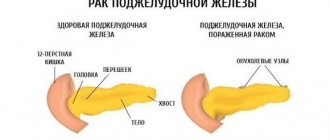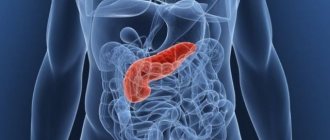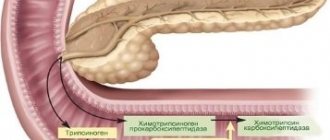The pancreas plays an important role in the human body. In the digestive system, it ranks second in size after the liver. It has several types of tissue and is located in the upper abdomen deep inside the abdominal cavity behind the stomach. If you visualize this organ, then it is a slightly elongated formation, gray-pink in color, having in its structure such parts as:
- head;
- body;
- tail;
Not all people know about the existence of this organ in the body, however, it performs significant functions:
- Intrasecretory. The hormones lipocoin, glucagon and insulin are produced, which regulate sugar levels in the body.
- Exocrine. Releases enzymes into the duodenum to improve food digestion.
Functions of the gland
In the digestive tract, the pancreas is involved in the breakdown and digestion of all food elements:
- Proteins (proteases),
- Fats (lipase),
- Carbohydrates (amylase).
It also releases a lot of hormones that regulate metabolism. One of the main functions of the gland is to regulate glucose levels in the body through the secretion of insulin by beta cells, a hormone that reduces blood sugar levels.
Normal anatomy
Enzymes are secreted through the pancreas duct into the cavity of the duodenum, where digestion and absorption of nutrients from food occurs.
In addition to insulin, the endocrine function is the production of glucagon (a hormone that increases the amount of glucose), somatostatin (blocks the division of various cells), pancreatic polypeptide (a protein that inhibits the work of the pancreas and at the same time increases the secretion of gastric juice), ghrelin (a hormone that increases appetite).
The structure of the pancreas
The organ is an elongated formation that has a grayish-pink color, has a lobular structure and is located in the abdominal cavity behind the stomach and is closely adjacent to the duodenum.
The length of the adult gland is normally from 14 to 22 cm, and the width is from 3 to 9 cm. The gland is 9 cm wide in the head area.
The weight of the organ in normal condition is from 70 to 80 grams.
The macroscopic structure of the gland is divided into three sections:
- head;
- body;
- tail.
The head is adjacent to the duodenum. The body has a triangular shape. The tail of the pancreas is cone-shaped.
Causes of gland enlargement
Various diseases and pathological conditions can be accompanied by an enlarged pancreas. Enlargement of the body, tail, enlargement of the head of the pancreas, the reasons can be varied. The organ can be completely enlarged or just one part of it. It usually occurs in adults, but recently it has increasingly affected adolescents, children with serious malnutrition, severe stress and congenital pathologies (in particular, cystic fibrosis).
List of main diseases, etiological factors:
- Acute or chronic inflammation;
- Damage from alcohol, tobacco, drugs, various toxins;
- Systemic infections, sepsis, septicemia;
- Embolism of organ vessels;
- Gallstone disease (women at risk during pregnancy and after menopause);
- The tumor is benign or malignant (part of the gland enlarges); with metastases, the foci can be located diffusely;
- Cysts that appear as complications of chronic pancreatitis, as well as with echinococcosis and other parasitic diseases leading to the formation of cysts;
- Abscess as a result of migration of infection and encapsulation of bacteria.
The rate of increase may be different; if it is fast, then the patient may feel pain and heaviness in the hypochondrium; if it is slow, then the person may not know that he is suffering from any pathology. In acute diseases, the clinic is brighter and is accompanied by various other symptoms.
Dangerous effects of alcohol
Diffuse or local enlargement is classified according to the type of hypertrophy (increase in cell size) and hyperplasia (increase in the number of cells).
Dimensions and location
The pancreas is located behind the stomach. The appearance is a slightly elongated organ of gray-pink color.
Depending on the sources of blood supply, the organ is divided into three projection points:
- the head, which is provided by blood flow from the vessels of the mesenteric artery;
- the body receives its main blood flow from the splenic artery;
- the tail receives nutrition from two sources: the gastroepiploic and splenic arteries.
In the projection of the head of the pancreas, its location is usually asymmetrical to the rest of the organs: the normal head of the pancreas is located slightly above the rest of the gland, while the remaining parts are slightly lower.
During diagnosis, the organ is projected onto the wall of the abdominal cavity in three different planes: epigastric, umbilical and subcostal cavity.
The normal size of the head depends on the age of the patient, and is usually 18-26 mm. Exceeding these data indicates serious disturbances in the functioning of internal organs.
Symptoms of an enlarged gland
The clinical picture with an enlarged pancreas may be absent. An increase of several millimeters may not be pathological and may not be a manifestation of pathology.
Symptoms of pancreatic dysfunction:
- Bloating, especially after eating;
- Pain or heaviness in the area of the left hypochondrium, projection of the gland;
- Pain when pressing on this area;
- Indigestion, malabsorption, weight loss;
- Metabolic disorders - decreased protein in the blood with characteristic manifestations, changes in glucose levels;
- The appearance of diarrhea with undigested elements in the stool, the presence of protein, lipids and carbohydrates in the stool;
- Constipation with the appearance of intestinal obstruction;
- Periods of exacerbation with severe sharp pain, fever, vomiting and diarrhea;
- Clinical signs of concomitant diseases that led to pathology of the gland or complications of pancreatic insufficiency;
- Infectious-toxic shock, fever and chills, if we are talking about a bacterial or viral disease;
- Skin itching, abdominal pain due to parasitic infestations.
The clinic can be bright or sluggish, manifested by exacerbations and remissions, depending on the pathology that caused it.
Chronic inflammatory process, epidemiology
No less important information about pancreatitis during pregnancy - treatment methods, possible complications
Symptoms
An enlarged pancreas in an adult can manifest itself in a wide variety of symptoms. In the early stages of the disease, the patient usually does not show any complaints, and his health does not worsen. In some cases, the appearance of severe symptoms is noted already in the first days of the pathological process.
An ultrasound examination is performed in all patients with suspected pancreatic enlargement
The most characteristic symptoms of an enlarged pancreas are pain. They can have a different character - from dull aching to sharp and shooting. Some patients may complain of a burning sensation. The location of pain can also vary. Most often the symptom is localized in the area above the navel, but sometimes it can radiate to the left arm or back.
With pancreatitis and malignant neoplasms, an increase in body temperature is possible. Depending on the intensity of the pathological process, it can be either low-grade or quite high.
Damage to the liver along with the pancreas manifests itself as digestive disorders. Their symptoms are quite varied. Diarrhea and flatulence often occur. In severe cases, nausea and vomiting may occur. This is due to a deficiency of digestive enzymes. As a result, food is insufficiently digested and irritates the intestinal walls.
If the pancreas is enlarged in the head area, which leads to compression of the duodenum, constipation may occur. In cases where this part of the organ is of significant size, intestinal obstruction may develop. This condition requires emergency surgical care, as it threatens severe complications.
To summarize the above, we can say that the doctor may suspect that the pancreas is enlarged if there is pain in the upper abdomen, diarrhea, nausea and fever. These symptoms may be an indication for laboratory tests and instrumental diagnostic procedures.
Diagnosis of gland enlargement
At the first consultation, the doctor listens to the patient’s complaints, examines him and examines each organ system in detail, palpates the abdominal organs, listens to breathing and heart rate. It is important to pay attention to the liver, pancreas, stomach and intestines.
Afterwards, to establish a diagnosis, various laboratory and instrumental tests are prescribed:
- Complete blood count to detect signs of anemia, inflammation, platelet count;
- Biochemical blood test to analyze the condition of organs (ALT, AST and bilirubin - liver, amylase - pancreas, creatinine and urea - kidneys, plus analysis of the amount of proteins);
- Ultrasound examination, where you can see the condition of the pancreas, possible complications, its size, structure;
- Urine analysis for the presence of lipase, amylase;
- Serum ribonuclease;
- If radiography is prescribed, indirect signs of inflammation, tumor and other pathologies can be determined, in particular, the same as with computed tomography;
- The gold standard for determining the detailed condition of the pancreas is magnetic resonance imaging, which shows the smallest structures;
- Diagnostic laparoscopy, which can identify both indirect and direct signs of necrosis, determine the condition of adjacent tissues and surgical treatment tactics. The problem must be solved on the spot so that the patient does not tolerate the new anesthesia;
- Angiography. In inflammatory and destructive pathologies, the vessels are the first to suffer, which is why the nutrition and functioning of the organs and tissues near them are disrupted. Angiography determines the state of blood flow and determines the prognosis, helps in establishing future treatment tactics.
- Fibrogastroduodenoscopy. Additional research is used for differential diagnosis.
When a patient is admitted to the emergency department in serious condition and diagnosed with an enlarged pancreas, it is necessary to determine treatment tactics. Based on the medical history, complaints and research results, the doctor determines the severity and risk for the patient. The Ranson scale is used for this.
Risk factors
Criteria for determining the severity of the patient:
- Age;
- Indicators of AST, LDH, glucose, leukocyte count;
- Assessment of the above indicators after 48 hours after hospitalization;
- APACHE II score of more than 8 points;
- The presence of failure of any organ.
Based on the assessment, doctors decide how quickly it is necessary to take the patient to the surgical table. Before surgery, the patient is stabilized:
- Relieves pain
- Improves the rheological properties of blood,
- Block enzyme activity
- Stabilizes blood pressure and sinus rhythm.
If the general condition is satisfactory, then the patient may not need hospitalization, the above diagnostic methods and symptomatic treatment are prescribed, and after diagnosing the cause, treatment at home is prescribed.
Permitted and prohibited products
Diagnostic methods and treatment
If the patient has signs that may indicate an enlarged pancreas, an abdominal ultrasound should be performed. In order to assess the general condition of the body, blood and urine tests are also performed. If indicated, other types of examinations are also carried out.
For pancreatitis, drug therapy is necessary
Treatment of the disease is determined by the data obtained from ultrasound examination. If signs of acute pancreatitis are detected, the patient is hospitalized in a therapeutic hospital, where he is treated with medications. In cases where stones, ulcers or pseudocysts are detected in the organ, the patient is referred to a surgeon. In this case, surgery is necessary, but sometimes conservative methods can be used.
Chronic inflammatory processes require conservative treatment, which is usually carried out in a hospital. If there is a suspicion of an oncological process, the patient is referred to an oncologist, who prescribes additional examinations to clarify the diagnosis.
Drug therapy includes the following steps:
- therapeutic diet;
- the use of hormonal agents and histamine receptor blockers to suppress the secretion of pancreatic juice;
- the use of enzymes to replace missing ones and restore normal functioning of the digestive system.
The use of these treatment methods is sufficient to cure inflammatory pathologies of the organ. The most important role is played by therapeutic nutrition, which reduces the load on the diseased gland.
An increase in the size of the pancreas may not bother a person for a long time. Nevertheless, this is a phenomenon that may indicate the presence of severe pathology. Early diagnosis increases the chances of successful treatment and prevention of complications of the disease.
Only a doctor can determine what to do if such a pathology is detected. After all, the choice of treatment methods depends on what caused the change in the size of the gland. Depending on the cause of the pathology, the following methods are used:
- applying cold;
- following a special diet, and sometimes completely refusing food for several days;
- use of medications;
- surgical intervention.
In case of chronic course of the pathology, outpatient treatment is possible, but in case of acute pancreatitis or in case of abscess formation, it is necessary to urgently place the patient in a hospital.
Nutrition
Diet is the main method of treatment for any pathology of the pancreas. After all, its job is to produce enzymes for digesting food. Therefore, gentle nutrition reduces the load on this organ and prevents complications. In some cases, only one diet without the use of other methods allows the organ to return to its normal size.
The most important thing is to completely eliminate alcoholic beverages and fatty dairy products. It is prohibited to consume meat or fish broths, spicy and fried foods, raw vegetables and fruits, and freshly squeezed juices.
Basically, for all diseases of the pancreas, the Pevzner diet is prescribed. It involves increasing the proportion of protein in food and almost completely limiting fat. The diet should include lean meats and fish, low-fat dairy products, crackers or biscuits, cereals, and vegetable dishes. All foods need to be boiled, stewed or baked. It is advisable to eat food 5-6 times a day in small portions.
If the pancreas is enlarged, diet should be the main treatment method.
If the pancreas is enlarged, special medications will help bring it back to normal. Most often, proton pump inhibitors are prescribed for this, for example, Omeprazole and histamine receptor blockers. They help reduce the secretion of pancreatic juice.
In addition, enzyme preparations are needed that help digest food, relieving the load on the pancreas. Most often these are Pancreatin, Mezim-Forte, Festal. And to relieve pain and inflammation, painkillers and anti-inflammatory drugs are prescribed: No-Shpa, Ketorol, Ibuprofen or Paracetamol. Cerucal, Domperidone, Itopride are effective against nausea and vomiting.
Surgical treatment
Conservative treatment is not always effective for this pathology. If the enlargement of the pancreas is associated with the appearance of an abscess, acute pancreatitis, or blockage of the ducts, urgent surgical intervention is necessary. Therefore, the patient is taken to the hospital, where the doctor, after examination, decides on the need for surgery.
Pancreatic enlargement is a common and quite serious pathology. Only timely treatment with elimination of the cause of this condition will help to avoid complications and normalize digestion.
Treatment and symptoms of pancreatic tumor
Adelina Pavlova
General nurse. More than 40 years of working experience. Retired copywriter.
More about the author
Last updated: April 18, 2018
Ultrasound of the peritoneum
If the doctor suspects that the patient has an enlarged pancreas, he will first of all issue a referral for an ultrasound scan of the abdominal cavity. A general and biochemical blood test, urinalysis and other studies are also required - for special indications.
Based on the ultrasound and other results, the gastroenterologist can make a diagnosis or refer the patient to other doctors. So, when there are obvious symptoms of acute pancreatitis or an abscess, urgent hospitalization is necessary. The surgeon will determine what treatment is needed - conservative or surgical. If the cause of the problem is a pseudocyst, the surgeon will also decide what to do.
Chronic inflammation requires treatment in a hospital with subsequent observation by a gastroenterologist. Sometimes endoscopic surgery is necessary (for example, if there are stones in the ducts). When there are signs of a tumor in the pancreas, consultation with an oncologist is necessary.
What to do when tests show an enlarged gland? Treatment may include several methods depending on the cause and stage of the disease:
- Special strict diet.
- Suppression of pancreatic secretory activity (hormonal drugs or histamine receptor blockers).
- Taking artificial enzymes to normalize the functioning of the digestive system.
- Surgical treatment (removal of the affected lesion).
A gastroenterologist can recommend additional consultations with an infectious disease specialist, surgeon, or oncologist. Before visiting a doctor, you must adhere to several rules. Do not heat the abdominal area or drink alcohol. It is necessary to remove everything fried, fatty, smoked and spicy from your diet.
And only in rare cases is surgery required. A more detailed description of the course of treatment depends on the individual case, the course of the disease and the diagnosis.
Before starting treatment and relieving inflammation of the organ, it is necessary to consult several specialists to exclude the presence of concomitant diseases.
Most often, treatment of the pancreas will consist of complex measures: switching to dietary nutrition, physiotherapy and, in cases of moderate disease, taking medications.
The option of surgical intervention is considered for each individual patient depending on the severity of the disease; pancreatic surgery is performed only as a last resort.
Treatment of an enlarged pancreas is carried out comprehensively with the prescription of drugs from different groups:
- Painkillers. For moderate pain, limit treatment to non-steroidal anti-inflammatory drugs. To relieve very severe pain, a narcotic painkiller administered intramuscularly can be used. If the nature of the unpleasant sensations is spastic, then taking antispasmodics is appropriate.
- Enzymes.
- Treatment of body intoxications.
- Antibiotics. Inflammatory processes are not always caused by infection, but it tries to join as quickly as possible.
If the pancreas is enlarged, the causes, treatment and diet are determined by the doctor depending on what exactly is happening in the body. Based on these studies, a diagnosis can be made, additional tests can be prescribed, or referrals to other specialists can be made. Conclusions about further treatment are based on the diagnostic results:
- When the reasons that the pancreas is enlarged are acute pancreatitis or an abscess, urgent medical attention is required. For this, the patient is hospitalized, and then they decide what needs to be done: surgery or treatment with medication.
- The presence of a pseudocyst will also force the organ to enlarge, and the patient to visit a surgeon, who will decide what to do with the disease.
In general, treatment of pancreatic enlargement most often requires inpatient monitoring, since in many situations surgical intervention or taking quite serious medications under the supervision of specialists is required. First, the patient is prescribed a diet, since the enlarged pancreas is sensitive to the food entering the body.
Another direction of treatment may be taking enzymes that compensate for the insufficient activity of the organ, or, conversely, suppressing its activity.
When a doctor initially examines a patient, it is impossible to identify the true factor of inflammation of the head. The doctor examines the medical history, examines the patient using palpation, and then, based on the complaints, determines a further examination plan. An accurate diagnosis can be made if laboratory and instrumental tests are completed.
blood analysis
Diagnosis of diseases includes:
- general blood test - to study the coefficient of leukocytes, lymphocytes, platelets, ESR, hemoglobin;
- blood for sugar - the presence of cancer will show a high concentration of glucose;
- biochemical study for bilirubin, diastase, transaminases, cholesterol and protein. If these values are elevated, then cancer of the head of the pancreas is detected;
- blood for tumor markers;
- urine test - necessary to detect bile pigments and urobilin;
- feces are examined for homogeneity, the presence of undigested food, drops of fatty inclusions, greasy shine, and a specific odor. If any, it will indicate cancer of the head.
Treatment of the disease
If, in addition to an increase in size, no other pathological process is diagnosed in the gland and other organs, if the patient does not have any complaints or external signs, then treatment is not prescribed, and the patient is prescribed an ultrasound to monitor the condition.
When a diagnosis of chronic pancreatitis is made, the patient is prescribed individual therapy, which includes:
- Therapeutic diet;
- Changing your daily routine;
- Medicinal supportive and symptomatic treatment;
- Clinical examination;
- Sanatorium treatment.
Medicines that are used for chronic pancreatic insufficiency:
- Painkillers for pain management (non-steroidal anti-inflammatory drugs);
- Therapy to replace the lack of enzyme production (Creon, Mezim, Pancreatin) is used only if a deficiency is diagnosed, with hyposecretory pancreatitis;
- Antibiotics or antibacterial drugs if there is a bacterial infection;
- Vasodilators and antispasmodics;
- In case of acute inflammation and destruction, enzyme blockers and anticoagulants are prescribed to prevent complications;
- Vitamin therapy;
- In the event of the appearance of gallstones, which often occurs as complications, special therapy is prescribed;
- Treatment of deficiency of insulin secretion.
Diet is one of the most important links; without following a diet, no medications or surgeries will give the desired result.
Diet reminder
Surgical intervention is prescribed in the presence of complications:
- Pancreatic necrosis;
- Gallstones, which obstruct the flow of bile and lead to sclerosis or inflammation of the bile ducts (cholangitis);
- Inflammation of the gallbladder (cholecystitis);
- Abscess or phlegmon, peritonitis;
- Bleeding;
- Presence of cysts or pseudocysts;
- The tumor is malignant or hormone-secreting;
- Pathology of the main vessels.
The operation can be planned, in case of a stable condition, or emergency, when the pathology threatens the patient’s life.
Doctor Komarovsky's opinion
According to the famous doctor Evgeniy Olegovich Komarovsky, host of the “Doctor Komarovsky School” program, if a child is suspected of having a pancreatic disease, he should immediately consult a doctor and undergo the necessary examinations in order to identify the danger and take timely measures. If the suspicions are not justified, but the organ is still enlarged, then this is a natural deviation caused by the development of the body. It is enough to eat right and soon the pancreas itself will return to normal.
Diet for enlarged glands
If you have digestive problems caused by pancreatic pathology, you must strictly follow the rules of the diet prescribed by your doctor. Fulfilling this condition is 50% success.
- In the case of an acute course of the disease, doctors will prescribe fasting for some time, this will reduce the need for enzyme secretion;
- In case of a chronic process, some foods must be completely excluded, a food intake regime must be created, and the volume of portions must be determined;
- Quit tobacco and alcohol completely;
- Avoid stressful situations;
- Try to get enough sleep;
- Drink plenty of fluids.
Basic rules and dishes that can be consumed if you have problems with the pancreas:
- Boiled, stewed, baked dishes;
- Soft warm food;
- Frequent meals in small portions;
- Lean meat and fish, dairy products;
- Vegetables and fruits are preferably boiled or stewed;
- Refusal or minimization of confectionery and flour products.
What to avoid:
- Sour, hot and spicy dishes;
- Fried foods;
- Fatty food;
- Fast food;
- Fresh fruits and vegetables.
Preventive methods
Treatment of pancreas when it is enlarged
Before using medical products of synthetic origin.
Dietary nutrition has a good therapeutic effect on the condition of the pancreas. For this purpose, you should avoid eating spicy, smoked and fatty foods.
The gland in an adult can be brought back to normal by using a whole range of drugs.
Most often, tablets belonging to certain groups of drugs are prescribed.
Drug treatment of acute or alcoholic pancreatitis can be carried out at home.
The following groups of drugs are used for this purpose:
- proton pump inhibitors;
- hormonal agents;
- drugs – histamine receptor blockers;
- products containing pancreatic enzymes.
Additionally, it is possible to use antipyretic, antiemetic and painkillers. A tablet of Ibuprofen or Ketorol quickly relieves pain. To lower the temperature, you can use Paracetamol or Citramon. These medications should be used with extreme caution if treatment is carried out on a woman who is in the process of bearing a child.
Effective antiemetic drugs during treatment are such drugs as:
When treating a disease at home, it should be accompanied by adherence to a dietary diet.
The basis of the diet includes various cereals and lean meat. It is forbidden to use in the diet those foods that require increased secretion of pancreatic juice. Consumption of alcoholic beverages is prohibited.
With timely treatment, it is possible to avoid serious complications in the body.
In childhood, a pathological condition of the gland may be recorded, which is caused by a hereditary predisposition. When treating an enlarged pancreas in a teenager, both conservative and surgical treatment can be used. The choice of treatment method is made by the attending physician, taking into account the characteristics of the body.
Information about pancreatic diseases is provided in the video in this article.
Cases where a person has an enlarged pancreas have long ceased to be rare. Many people suffer from a wide variety of diseases directly or indirectly related to this organ. And although problems associated with the pancreas remain with a person for life, modern medicine makes it possible to keep them under control.
Consequences of diseases
If you do not start treating the diagnosed pathology in a timely manner, this can lead to various complications that were described above, and a decrease in the functionality of organs.
It is worth remembering that not every disease requires drug intervention, but diagnosis is a mandatory step. Only a doctor can decide whether treatment is necessary, or whether it is possible to cope with the help of a regimen and observation.
In gastroenterology, nutrition is the most important indicator that determines which risk groups a person belongs to, what pathology can be assumed if an enlarged pancreas is detected, family history and concomitant diseases are also important information. Determining the cause of a particular syndrome is a complex process in which all the facts must be taken into account. Some conditions do not require medical intervention, some indicate the presence of gland pathology.
Possible complications and prevention
One of the most common complications of any pancreatic disorder is acute or chronic pancreatitis. This disease is an inflammatory process affecting the walls of the pancreas. If timely treatment is not carried out, tissue necrosis or numerous abscesses may develop.
In the most severe cases, consequences can develop that pose a direct danger to human life, such as pancreatic cancer.
The most effective way to prevent this disease is to normalize nutrition. The sooner a person can give up junk food and start eating right, the higher the chances of avoiding such disorders. Physical activity will be useful. It is better to start with light exercises, gradually increasing the load.
It is worth remembering that an increase in the size of the pancreas occurs under the influence of serious pathologies, so in no case should you self-medicate. What to do in this case, the doctor must decide.










